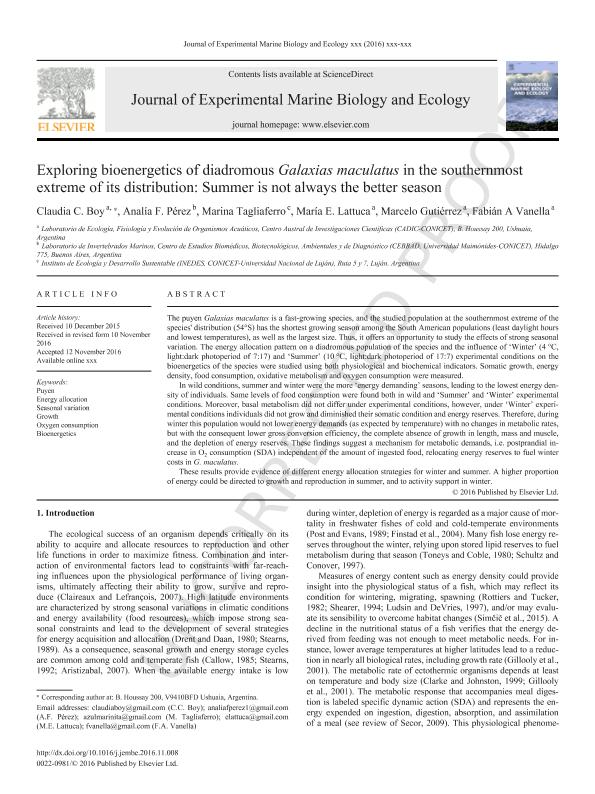Mostrar el registro sencillo del ítem
dc.contributor.author
Boy, Claudia Clementina

dc.contributor.author
Pérez, Analía Fernanda

dc.contributor.author
Tagliaferro, Marina Beatriz

dc.contributor.author
Lattuca, María Eugenia

dc.contributor.author
Gutierrez, Marcelo Eduardo

dc.contributor.author
Vanella, Fabián Alberto

dc.date.available
2019-03-29T17:52:55Z
dc.date.issued
2017-03
dc.identifier.citation
Boy, Claudia Clementina; Pérez, Analía Fernanda; Tagliaferro, Marina Beatriz; Lattuca, María Eugenia; Gutierrez, Marcelo Eduardo; et al.; Exploring bioenergetics of diadromous Galaxias maculatus in the southernmost extreme of its distribution: Summer is not always the better season; Elsevier Science; Journal of Experimental Marine Biology and Ecology; 488; 3-2017; 102-110
dc.identifier.issn
0022-0981
dc.identifier.uri
http://hdl.handle.net/11336/72844
dc.description.abstract
The puyen Galaxias maculatus is a fast-growing species, and the studied population at the southernmost extreme of the species’ distribution (54°S) has the shortest growing season among the South American populations (least daylight hours and lowest temperatures), as well as the largest size. Thus, it offers an opportunity to study the effects of strong seasonal variation. The energy allocation pattern on a diadromous population of the species and the influence of ‘Winter’ (4 °C, light:dark photoperiod of 7:17) and ‘Summer’ (10 °C, light:dark photoperiod of 17:7) experimental conditions on the bioenergetics of the species were studied using both physiological and biochemical indicators. Somatic growth, energy density, food consumption, oxidative metabolism and oxygen consumption were measured. In wild conditions, summer and winter were the more ‘energy demanding’ seasons, leading to the lowest energy density of individuals. Same levels of food consumption were found both in wild and ‘Summer’ and ‘Winter’ experimental conditions. Moreover, basal metabolism did not differ under experimental conditions, however, under ‘Winter’ experimental conditions individuals did not grow and diminished their somatic condition and energy reserves. Therefore, during winter this population would not lower energy demands (as expected by temperature) with no changes in metabolic rates, but with the consequent lower gross conversion efficiency, the complete absence of growth in length, mass and muscle, and the depletion of energy reserves. These findings suggest a mechanism for metabolic demands, i.e. postprandial increase in O2 consumption (SDA) independent of the amount of ingested food, relocating energy reserves to fuel winter costs in G. maculatus. These results provide evidence of different energy allocation strategies for winter and summer. A higher proportion of energy could be directed to growth and reproduction in summer, and to activity support in winter.
dc.format
application/pdf
dc.language.iso
eng
dc.publisher
Elsevier Science

dc.rights
info:eu-repo/semantics/openAccess
dc.rights.uri
https://creativecommons.org/licenses/by-nc-nd/2.5/ar/
dc.subject
Bioenergetics
dc.subject
Energy Allocation
dc.subject
Growth
dc.subject
Oxygen Consumption
dc.subject
Puyen
dc.subject
Seasonal Variation
dc.subject.classification
Otras Ciencias Biológicas

dc.subject.classification
Ciencias Biológicas

dc.subject.classification
CIENCIAS NATURALES Y EXACTAS

dc.title
Exploring bioenergetics of diadromous Galaxias maculatus in the southernmost extreme of its distribution: Summer is not always the better season
dc.type
info:eu-repo/semantics/article
dc.type
info:ar-repo/semantics/artículo
dc.type
info:eu-repo/semantics/publishedVersion
dc.date.updated
2019-03-29T12:06:26Z
dc.journal.volume
488
dc.journal.pagination
102-110
dc.journal.pais
Países Bajos

dc.journal.ciudad
Amsterdam
dc.description.fil
Fil: Boy, Claudia Clementina. Consejo Nacional de Investigaciones Científicas y Técnicas. Centro Austral de Investigaciones Científicas; Argentina
dc.description.fil
Fil: Pérez, Analía Fernanda. Universidad Maimónides. Área de Investigaciones Biomédicas y Biotecnológicas. Centro de Estudios Biomédicos, Biotecnológicos, Ambientales y de Diagnóstico; Argentina. Consejo Nacional de Investigaciones Científicas y Técnicas; Argentina
dc.description.fil
Fil: Tagliaferro, Marina Beatriz. Universidad Nacional de Luján. Instituto de Ecología y Desarrollo Sustentable. Consejo Nacional de Investigaciones Científicas y Técnicas. Oficina de Coordinación Administrativa Parque Centenario. Instituto de Ecología y Desarrollo Sustentable; Argentina
dc.description.fil
Fil: Lattuca, María Eugenia. Consejo Nacional de Investigaciones Científicas y Técnicas. Centro Austral de Investigaciones Científicas; Argentina
dc.description.fil
Fil: Gutierrez, Marcelo Eduardo. Consejo Nacional de Investigaciones Científicas y Técnicas. Centro Austral de Investigaciones Científicas; Argentina
dc.description.fil
Fil: Vanella, Fabián Alberto. Consejo Nacional de Investigaciones Científicas y Técnicas. Centro Austral de Investigaciones Científicas; Argentina
dc.journal.title
Journal of Experimental Marine Biology and Ecology

dc.relation.alternativeid
info:eu-repo/semantics/altIdentifier/url/https://www.sciencedirect.com/science/article/pii/S0022098116302519
dc.relation.alternativeid
info:eu-repo/semantics/altIdentifier/doi/http://dx.doi.org/10.1016/j.jembe.2016.11.008
Archivos asociados
